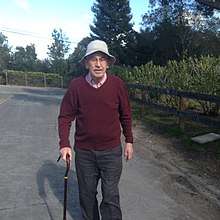Ian R. Gibbons
| Ian Read Gibbons FRS | |
|---|---|
 | |
| Born |
30 October 1931 in Rye, Sussex, England |
| Died |
30 January 2018 (aged 86) in Orinda, California, USA |
| Nationality | British |
| Alma mater |
King's College, Cambridge Cambridge University (BA), (PhD) |
| Known for | Work in cell mobility |
| Awards |
|
| Scientific career | |
| Doctoral advisor | John Bradfield |
Ian Read Gibbons, FRS (30 October 1931 – 30 January 2018) was a biophysicist and cell biologist.
He studied at the University of Cambridge, from which he graduated with a Bachelor of Arts (BA) degree in 1954 and a Doctor of Philosophy (PhD) degree in 1957. He did his postdoctoral research at University of Pennsylvania, and discovered and named the molecular motor dynein while working as an assistant professor at Harvard University. He moved to the University of Hawaii Kewalo Marine Laboratory in 1967, and in 1972 he successfully demonstrated the sliding tubule mechanism of flagellar motility by taking films and using a light microscope to show reactivated sea urchin sperm flagella. The flagella disintegrated when microtubules visibly slid out of the ends of the flagellar fiber. Following his retirement from the University of Hawaii, he became a Visiting Researcher at the Department of Molecular and Cell Biology, University of California, Berkeley in the lab of Beth Burnside. His work deals with cell mobility, in particular the molecular organization of flagella and cilia.
Professional work
Gibbons was a founding member and later a director (1993-1996) of the Kewalo Marine Laboratory[1] of the University of Hawaiʻi at Mānoa on the island of Oahu, Hawaii.
Awards
- 1983: Fellow of the Royal Society (FRS)[2]
- 1994: E.B. Wilson Medal with Barbara Gibbons[3]
- 1995: International Prize for Biology
- 2017: Shaw Prize in Life Science and Medicine with Ronald Vale for their discovery of microtubule-associated motor proteins[4]
References
- ↑ History of Kewalo Marine Laboratory, University of Hawaiʻi at Mānoa
- ↑ Ian Gibbons presentation on the Royal society website
- ↑ Fleischman, John (July 23, 2013), In Memoriam – Barbara Hollingworth Gibbons
- ↑ Shaw prize laureate 2017